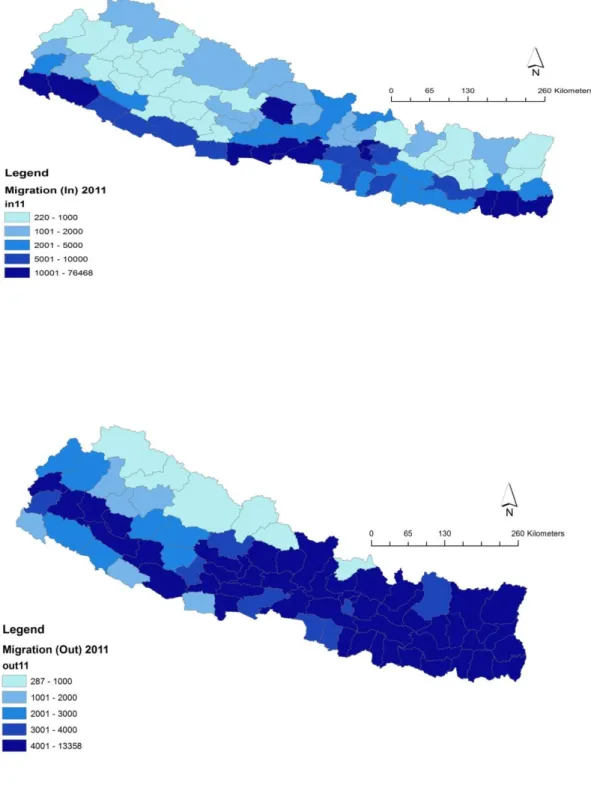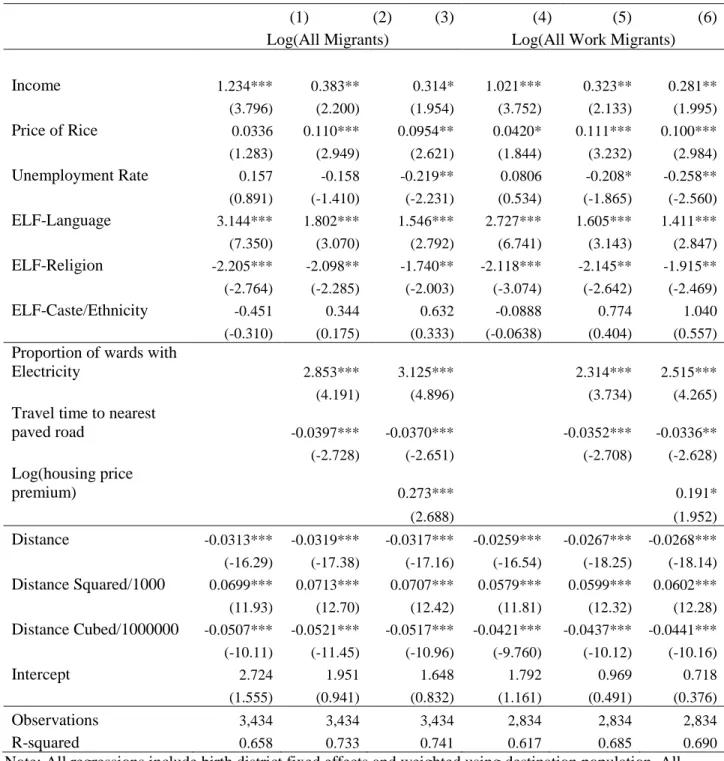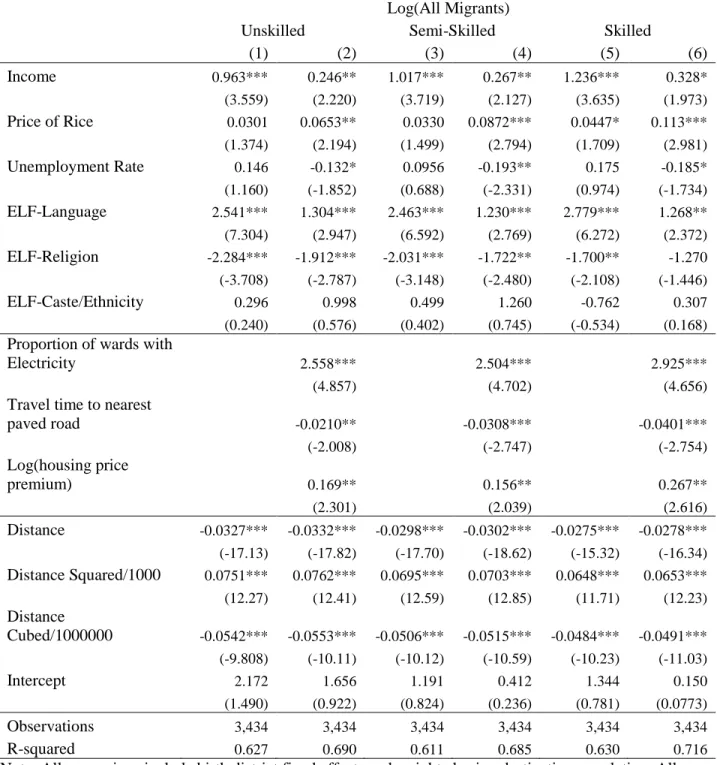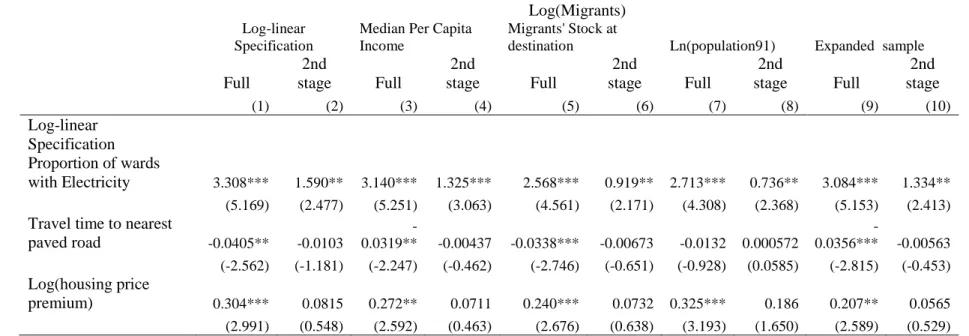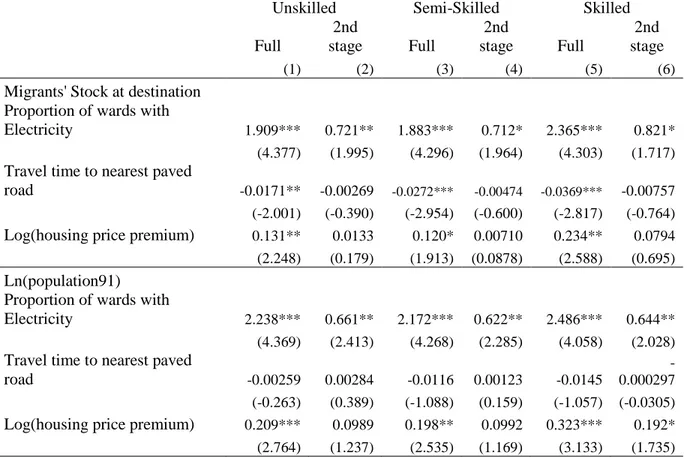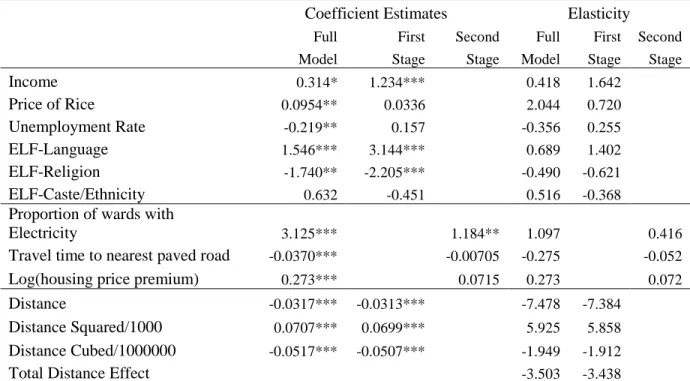Policy Research Working Paper 7047
Voting with Their Feet?
Access to Infrastructure and Migration in Nepal
Forhad Shilpi Prem Sangraula
Yue Li
Development Research Group
Agriculture and Rural Development Team
WPS7047
Public Disclosure Authorized Public Disclosure Authorized Public Disclosure Authorized Public Disclosure Authorized
Abstract
The Policy Research Working Paper Series disseminates the findings of work in progress to encourage the exchange of ideas about development issues. An objective of the series is to get the findings out quickly, even if the presentations are less than fully polished. The papers carry the names of the authors and should be cited accordingly. The findings, interpretations, and conclusions expressed in this paper are entirely those of the authors. They do not necessarily represent the views of the International Bank for Reconstruction and Development/World Bank and its affiliated organizations, or those of the Executive Directors of the World Bank or the governments they represent.
Policy Research Working Paper 7047
This paper is a product of the Agriculture and Rural Development Team, Development Research Group. It is part of a larger effort by the World Bank to provide open access to its research and make a contribution to development policy discussions around the world. Policy Research Working Papers are also posted on the Web at http://econ.worldbank.org.
The authors may be contacted at fshilpi@worldbank.org.
Using bilateral migration flow data from the 2010 popu- lation census of Nepal, this paper provides evidence on the importance of public infrastructure and services in determining migration flows. The empirical specification, based on a generalized nested logit model, corrects for the non-random selection of migrants. The results show that migrants prefer areas that are nearer to paved roads and have
better access to electricity. Apart from electricity's impact on
income and through income on migration, the econometric
results indicate that migrants attach substantial amenity
value to access to electricity. These findings have important
implications for the placement of basic infrastructure proj-
ects and the way benefits from these projects are evaluated.
Voting with Their Feet? Access to Infrastructure and Migration in Nepal
Forhad Shilpi, Prem Sangraula, Yue Li
JEL classification: O18, R13, R23
Key words: Migration, Public Goods, Income Effect, Amenity Value
Introduction
Do migrants respond to di¤erences in access to public goods and services in addition to income prospects of potential destinations? The income di¤erence between the origin and the destination is the primary factor driving migration in the existing literature on migration (Greenwood (1975) and Borjas (1994), Lall, Selod and Shalizi (2006)). Along with income, recent literature has also highlighted the importance of migration costs as well as migrants’ networks in determining migration ‡ows. How provision of public goods and services may in‡uence migration in poorer developing countries remains sparsely studied. This issue is however important in these countries where provision of public goods varies widely across areas. In a Tiebout (1956) sorting model, such disparity in the provision of public goods such as roads, electricity, schools, hospitals, etc. should induce people to "vote with their feet" and to migrate to areas with better access to these infrastructures and services.
1From a policy perspective, it is important to know how migration responds to the provision of public goods in developing countries for a number of reasons. First, regions within a typical developing country are usually characterized by stark di¤erences in poverty and welfare. Households with poorer attributes such as low levels of education, skills and assets are frequently observed to live in poor areas that are characterized by lack of public infrastructure and services (Shilpi(2011), Dudwick et al. (2011), World Development Report (2009), Kanbur and Venables (2005), Jalan and Ravallion (2002), Ravallion and Wodon (1999)). If migrants do respond to income as well as provision of public infrastructure and services, then migration can act as a powerful instrument in mitigating regional di¤erences in welfare. Second, di¤erential costs of provision of infrastructure and services along with a hard budget constraint often force governments in developing countries to prioritize placement of these public goods. If people do migrate to gain better access to public goods, then the government may be able to rely more on cost considerations to prioritize their placement. Finally, migration in response to public goods and services also has important implications for the way the bene…ts of public investment are evaluated. A typical evaluation strategy
1Bayoh, Irwin and Haab (2006) …nds that central city’s inferior public goods, most notably school quality, play a dominant role in pushing households in the USA metropolitan cities to suburban locations.
of relying on variations in key outcomes such as income or household expenditure across areas with and without public goods would seriously underestimate the bene…t of the project. This is because migration in response to a new public good reduces the di¤erences in these outcomes across areas. Using census data from Nepal, this paper provides evidence on the extent to which access to public goods and services in‡uences bilateral migration ‡ow across areas.
The determinants of bilateral migration have been analyzed mostly in the context of international migration (Grogger and Hanson (2011), Ortega and Peri (2013)) and inter-regional migration (Ghatak, Mulhern and Watson (2008), Andrienko and Guriev (2004)).
2This literature however focuses primarily on income and migration costs as determinants of migration ‡ow. A recent literature examines how migrants’
choice of destination is in‡uenced by locational attributes including the state of public infrastructure and services. For a relatively richer developing country – Brazil – Lall, Timmins and Yue (2009) …nd that poor migrants are willing to accept lower wages to achieve access to better services while richer migrants are in‡uenced only by income di¤erences.
3Fafchamps and Shilpi (2013) …nd a statistically signi…cant and numerically large e¤ect of access to paved roads on migrants’destination choice in Nepal: migrants prefer a destination that is closer to a paved road. While contributing to this literature, the analysis in this paper di¤ers from the above papers in a number of ways. Instead of focusing on the destination choice of individual migrants, we analyze bilateral migration ‡ows across multiple sources and destinations. Our empirical speci…cation is derived from a model of utility maximization by the migrants proposed by Ortega and Peri (2013) and Grogger and Hanson (2011). We consider a generalized nested logit model where migrants …rst decide whether to migrate and then decide among the potential destinations. The advantage of this approach is that the resulting empirical speci…cation includes a correction term for the unobserved heterogeneity between migrants and non-migrants. The above mentioned papers (Fafchamps and Shilpi (2013), Lall, Timmins and Yue (2009)) in contrast side-stepped the issue of migrants’non-random selection
2For a survey of migration literature, please see Greenwood (1975) and Borjas (1994).
3For example, a Brazilian minimum wage worker earning R$7 an hour was willing to pay R$420 a year to have access to better health services, R$87 for a better water supply, and R$42 for electricity.
by focusing on the choice of destination conditional on migrating. More importantly, we make a distinction between the productivity and amenity values of basic infrastructure and services. For instance, access to electricity allows …rms to automate production, shifting the production possibility frontier ("productivity e¤ect"). It also helps households to carry out essential chores e¢ ciently and to enjoy leisure more fully ("amenity e¤ect"). We develop a strategy to uncover the amenity values of infrastructure and services. The strategy relies on a two-stage estimation procedure in which a canonical migration model –ignoring access to infrastructure and services – is …tted at the …rst stage. The …rst stage estimation thus allows income to capture the productivity e¤ect of the public goods. To the extent these goods are targeted to more productive areas, income in the …rst stage estimation picks up that placement e¤ect also. In the second stage, the residual from the …rst stage is regressed on measures of access to infrastructure and services. By construction, this strategy provides conservative estimates of amenity values of public goods.
The empirical analysis of this paper utilizes the detailed migration information from the population census 2010 of Nepal. Due to the mountainous terrain of the country and limited agricultural potential in many areas, migration is an important livelihood strategy for the Nepalese people. The rough terrain makes the provision of basic infrastructure very di¢ cult with the outcome that large parts of the country are not well served by transport infrastructure. Geographical coverage of electri…cation remains rather low, serving only a third of rural households. In terms of access to infrastructure and services as well as stage of economic development, Nepal is comparable to many Sub-Saharan African countries. The large geographical variations in access to basic public goods along with vibrant migration ‡ows make Nepal particularly suitable for our study.
When a standard migration model is …tted, our empirical results con…rm the common …ndings of the
migration literature that income and distance between source and destination are the two most important
determinants of bilateral migration ‡ow. Consistent with the …ndings of Fafchamps and Shilpi (2013),
we …nd that when measures of access to basic public goods are added as regressors, the magnitude of the
income coe¢ cient declines substantially though it still remains statistically signi…cant. This result con…rms
that the income coe¢ cient in a standard migration model is likely to be biased upward. Our results show that access to electricity and paved roads are important determinants of migration: migrants prefer areas with better access to electricity and paved roads. The results from the two-stage estimation procedures indicate that migrants attach substantial amenity value to access to electricity as well. Moreover, we
…nd that migrants of di¤erent skill levels (primary, secondary and tertiary education level) attach similar amenity values to access to electricity. Thus better access to electricity attracts migrants not only because it brightens their income prospects but also because it o¤ers better quality of life to them.
The rest of the paper is organized as follows. The conceptual framework and empirical speci…cation are presented in Section 2. Section 3 discusses the data. Section 4, organized in subsections, presents the empirical results. Section 5 concludes the paper.
2.Conceptual Framework 2.1 The Model
We start from a simple model of migration where an individual makes a utility maximizing migration decision among multiple destinations within the country. Individual h in her place of residence s decides whether to stay at s or to migrate to any of i 2 I = f 1; :::; N g : Let utility of individual h in location i be denoted U
ih. Following the literature, we assume that utility U
ihis a function of the income y
ih(or consumption) that the individual can achieve in location i, of the prices p
ihe or she faces, and a vector of location-speci…c amenities A
i(Bayoh, Irwin and Haab, 2006). The utility from migrating to a given destination i depends on the migrant’s utility from income and amenities suitably adjusted for prices [u
hi(y
hi; A
i; p
i)] and on the costs C
sihof moving from s to i. Following Grogger and Hanson (2008) and Ortega and Peri (2009), we make a distinction between factors that are shared by all migrants from the same origin and to the same destination, and individual speci…c factors. The utility in destination i can be expressed as:
U
sih=
si hsi= u(y
i; A
i; p
i) g(C
si)
hsi(1)
where
siis an origin-destination speci…c term shared by all individuals migrating from s to i and
hsiis the individual migrant speci…c term. u
i(y
i; A
i; p
i) is the expected utility of individual h in destination i.
The expected permanent income of individual h in destination i is the average income y
i: In the empirical estimation, we allow di¤erences in incomes for workers of di¤erent skill levels. The expected utility in the destination depends also on the services and amenities available there along with the cost of living. This is important particularly for internal migration where individuals and households may move not only to capture income gain but also to avail themselves of better services and amenities – for instance better schools or health services –at destination. Similarly, C
siis the average cost of migration from s to i. The cost term C
sicaptures the physical distance between origin and destination. It also re‡ects costs incurred by individuals due to social distances (e.g. cultural, ethnic and language di¤erences) between the origin and destination.
We assume that u is an increasing function of y
i; and A
i; and a decreasing function of p
i: We assume that g is an increasing function of C
si: Following Grogger and Hanson (2008), we assume that both u and g are approximately linear functions. In the case of no migration, the average expected utility is:
U
ssh= y
s+ A
sp
swhere ; and are positive constants. The utility from locating in i can be expressed as:
U
sih= y
i+ A
ip
iC
si hsi(2)
where > 0 is a parameter. The individual speci…c term
hsidenotes the idiosyncractic parts of the utility and cost associated with migration by individual h. There is now substantial evidence that migrants may be substantially di¤erent from non-migrants in terms of their ability, risk aversion and preferences.
Following Ortega and Peri (2009) we assume that:
h
si
= (1 )"
sifor i = s (3)
=
h+ (1 )"
sifor i 6 = s
where "
siis iid following an (Weibul) extreme value distribution.
iis an individual speci…c term that a¤ects migrants only and its distribution is assumed to depend on 2 [0; 1). Given that "
sihas an extreme value distribution, then
hsihas also an extreme value distribution (Cardell (1991). The migrant speci…c term
idoes not depend on destination and can be thought of capturing the di¤erences in preferences for migration.
Ortega and Peri (2009) show that utility maximization under the distributional assumptions leads to the following condition:
ln S
siln S
ssln S
iN= [y
iy
s] + [A
iA
s] [p
ip
s] C
si(4)
where S
si= m
si=n
s; S
ss= (n
sP
N i=1m
si)=n
s;and S
iN= m
si= P
N i=1m
si: n
sis the total native born population of s; m
siis the migrants born in s and gone to destination i; and
P
N i=1m
siis the total migrants from s to all possible destinations. S
siand S
iNare the share of migrants to location i in total native born population of s and total migrants from location s respectively. S
ssis the share native born population in s who chose to stay in s. The expression in equation (4) is very similar to an expression under standard logit formulation if = 0: The term in equation (4) corrects for the di¤erences in utility (due to income, amenity, prices and costs) between migrants and non-migrants (Ortega and Peri (2009)).
Subsitutiting for shares and solving for the logarithm of migration ‡ow (ln m
si), equation (4) can be re-written as:
ln m
si=
1y
i+
1A
i 1p
i 1C
si+
s+
si(5)
where
siis the zero-mean measurement error,
sis the origin …xed e¤ects and
1=
1;
1=
1;
1=
1
; and
1=
1. In the standard logit formulation ( = 0); the …xed e¤ects account for share of the stayers in the population along with income, amenity and prices at the origin [
s= ln(n
sP
N i=1m
si)].
When migrants di¤er systematically from non-migrants in preference and ability ( 6 = 0);the …xed e¤ects include a correction term (
1ln
P
N i=1m
si) for the average unobserved heterogeneity between migrants and non-migrants as well.
We estimate the speci…cation in equation (5) for bilateral gross migration ‡ows among districts in Nepal.
Following Grogger and Hanson (2011), we analyze sorting of migrants across destinations. Speci…cally, we analyze the variations in the skill mix of migrants to di¤erent destinations. We de…ne three groups of migrants in terms of their education level: those with (i) less than primary education, (ii) education between primary and secondary levels and (iii) above secondary level.
ln m
jsi=
j1y
ji+
j1A
i j 1p
i j1
C
si+
s+
jsi; for j = 1; 2; 3 (6)
where j represents the education levels of migrants. The speci…cations in equations (5) and (6) are based on a linear utility and migration cost functions. A linear formulation can be interpreted as monetary income and cost whereas a log-linear speci…cation would imply as log income and time cost (Ortega and Peri (2013)). We performed estimation using both linear and log linear speci…cations.
Equations (5) - (6) are the basis of our main empirical estimation. A number of things are worth noting in the estimation of equations (5-6). First, when su¢ cient numbers of migrants come to a destination, it is expected to have general equilibrium e¤ects on wages, incomes and access to services and amenities.
4This would generate a potential endogeneity bias due to the fact that income and amenities in a destination resulted in part from the decision of many migrants to locate there. To eliminate this bias, we use lagged explanatory variables. More precisely, let T be the period for which we have information on explanatory variables and T + t the period at which we observe migrants. Migrants are de…ned as those who migrated
4The e¤ect could be negative – e.g., congestion – or positive – e.g., agglomeration externalities.
between T and T +t whereas explanatory variables come from period T: Limiting the set of migrants in this fashion ensures that migration decisions are based only on information available prior to migration. Second, bilateral migration ‡ows between districts are not always positive. While our main estimation focused on districts with positive migration ‡ows, we also checked the robustness of our results for the sample which included districts with no migration ‡ows. We weight observations by destination population which corrects for potential heteroskedasticity of measurement error. The standard errors are clustered by destination districts to account for within (destination) district correlation of errors.
2.2 Empirical Speci…cation
The basic empirical speci…cations estimated from the data augment equations (5) and (6) with additional explanatory variables, leading to the following estimating equations:
ln m
si=
1y
i+
1A
i 1p
i 1C
si+
1Z
i+
s+
si(7) ln m
jsi=
j1y
ji+
j1A
i j1p
i j1C
si+
1Z
iJ+
s+
jsi; for j = 1; 2; 3 (8)
where Z
iis a vector of locational attributes of destination i. The Z
ivector includes controls for social proximity between source and destination in terms of language, religion and ethnicity. Following standard practice in the literature, we also include a measure of the unemployment rate as a control.
Suppose
1=
j1= 0, then equations (7 and 8) have the speci…cations that are comparable to speci…ca- tions derived from the standard model of determination of migration ‡ows when migrants’preferences for better access to public goods and services are ignored. For simplicity, suppose, y
iand A
iare uncorrelated with rest of the explanatory variables in the above equations and (
16 = 0;
j16 = 0):We estimate equation (7) ignoring A
i: The estimated coe¢ cient of income in this case is:
1
= ^
1+ ^
1(9)
where
1is the estimated income coe¢ cient when A
iis ignored and ^
1and ^
1
are the estimated income and amenity/public goods coe¢ cients from the full speci…cation (equation 7) and is the correlation between y
iand A
i: Since income tends to be higher in areas with better public goods, > 0: The income coe¢ cient (
1) thus overestimates the in‡uence of income di¤erences on migration ‡ow (^
1) when migrant’s preference for public goods is ignored.
The positive correlation between income and public goods means that part of the preference for public goods is due to a preference for higher income. Some of the basic public goods such as roads and electricity have not only direct productivity and hence income e¤ect but also amenity values as they make life easier for households. To explore the amenity value of these goods and services, we utilize a two-stage procedure.
At the …rst stage, we …t a standard migration model ignoring public goods, which allows income to pick up the productivity e¤ect of public goods and services. At the second stage, the residual from the …rst stage is regressed on the explanatory variables representing access to public goods and services. Similar to equation (9), it follows that:
1
= ^
1^
1where
1is the estimate of
1from the second stage regression.
1thus provides an estimate of the amenity value of public goods and services to migrants.
3. Data
The empirical analysis in this paper draws data from various sources: the population censuses of 2000 and 2010 and the Nepal Living Standard Survey 2002/3. The migration data are collected using the census long form for about 15 percent of the total population. This questionnaire collected information on district of current residence, district of residence 5 years prior to the census, and district of origin. Detailed information is also available on gender, age, education, religion, language spoken, ethnicity and motive for migration. This rich data-set is used to de…ne the gross bilateral migration ‡ows across districts.
55Nepal is divided into 75 districts.
The 15 percent sample of population census covers approximately 4.02 million individuals in 740,749 households. Because of our focus on adult migration, we restrict our attention to adults of age 15 and above. Of the 4.04 million individuals, about 35 percent are children below the age of 15 years. Among the adult population (about 2.65 million), about 18.7 percent are living in a district other than their district of birth. Among the migrants, 34 percent have moved in the six years preceding the census, that is, in the period between the 2002/3 NLSS and 2010 census. A large fraction of these individuals have moved for reasons other than work. Marriage is the dominant reason for moving among women (40 percent); study is the dominant reason for moving among children and youths (52 percent). In contrast, of the adult males who migrated during the last 6 years, 54 percent moved for work reasons. We estimate the migration
‡ows among districts using the census data and appropriate population weights. We de…ne two types of migrants: work migrants who moved to seek employment, and all migrants including work migrants as well as those who moved for non-work related reasons. All estimations are carried out for both of these samples.
Figure 1 shows the geographical distribution of migrants in terms of district of residence and origin.
As apparent from Figure 1, a small number of destination districts have a high proportion of migrants. In contrast, districts of origin are distributed widely across the country. This re‡ects the fact that much of the migration is from rural areas to towns and cities. Indeed more than 90 percent of the migrants come from rural areas, and more than half of them migrated to an urban area. The same migration pattern is observed for work migrants.
While the census provided information about migration, it did not collect any information on income, prices and access to services and amenities. We utilize a nationally representative survey of households – the Nepal Living Standard Survey 2002/3 –to derive these explanatory variables. To estimate the average income level in a district i, we ran a regression of the following speci…cation:
y
ih=
i+ x
hi+ v
ihwhere y
hiis the log of income of household h residing in district i,
iis the district …xed e¤ects, and x
hiis a vector of household level explanatory variables and v
hiis the residual term. The regression includes household size and composition (number of adult males, females and children) as explanatory variables as larger households with more adults tends to earn more income and consume more; omitting them would overestimate incomes in districts where households are larger, e.g., rural districts. Other household characteristics are not included because they could possibly be a¤ected by migration. The estimated ’s provide of average district income for all households. We also included controls for di¤erent education levels to estimate education premia. Incomes for di¤erent skill categories are then computed using the education premia.
In the empirical analysis, migration costs are captured by geographical and social distances. For ge- ographical distance between districts, we utilize the arc distance between the district of origin and each possible district of destination, computed from the average longitude and latitude of each district.
6We expect the cost and risk of migration to increase with physical distance. Social distance captures the e¤ect of migration networks which are found to be important in determining migration ‡ow ( Munshi (1993), Beaman (2012)). Social distance is measured by the index of ethno-linguistic fractionalization (ELF). The ELF index measures the probability that two individuals taken at random belong to the same ethnic or linguistic group. We estimated ELF for each district using the method suggested by Alesina and La Ferrara (2005). The ELF measures are de…ned for religious, linguistic and ethnic-caste groups using data from the 2000 population census. We computed the district level unemployment rate from the census 2000 data.
Instead of using the share of households with electricity, we construct a measure of electricity connection which does not depend directly on household income. We compute the share of wards – the smallest administrative unit in Nepal – that had electricity connection among all wards in a district using census
6The average longitude and latitude of a district are obtained as a weighted average of the longitude and latitude of all the VDC’s in the district, where the population of each VDC serves as weight.
2000 data.
7This de…nition of access to electricity avoids the correlation with income that would have resulted from the ability of households with higher incomes to get electricity connection had the access variable been de…ned at the household level. As a measure of access to markets and other services (schools, hospitals, etc.), we estimated travel time to the nearest paved road from NLSS 2002/2003 data. Travel time to the nearest paved road correlates strongly and positively with other measures of access to services such as travel time to schools, hospitals, local markets and formal banks.
To control for price, we use price of rice. Rice is the most commonly consumed food item in Nepal and thus can be taken as a proxy for the price of common household goods. The NLSS 2002/3 collected information on the quantity and price paid for rice by individual households. We use these data to compute a unit price per kg.
We construct a measure of housing cost using data from the NLSS 2002/3 survey which contained a separate section on housing. The survey collected information on hypothetical and actual house rental values of each household together with house characteristics such as square footage, number and type of rooms, quality of materials, and the availability of various utilities. We use these data to construct a hedonic index of housing costs for each district. Let r
ikbe the house rental price paid (or estimated) by household h in district i and let x
hidenote a vector of house characteristics. We estimate a regression of the form:
log r
ki= a
i+ bx
hi+ e
kiwhere estimate of b a
iprovides a measure the housing cost premium in each district i. In the regression -omitted for the sake of brevity –many of the house characteristics are signi…cant with the expected sign, e.g., larger, better built houses with better in-house amenities are worth more. District price di¤erentials are large and jointly signi…cant. Since the dependent variable is in log form, b a
imeasures the housing cost premium in each district.
Table 1 reports the summary statistics for the dependent and explanatory variables. On average about
7There are more than 35 thousand wards in 75 districts in our census long form sample.
